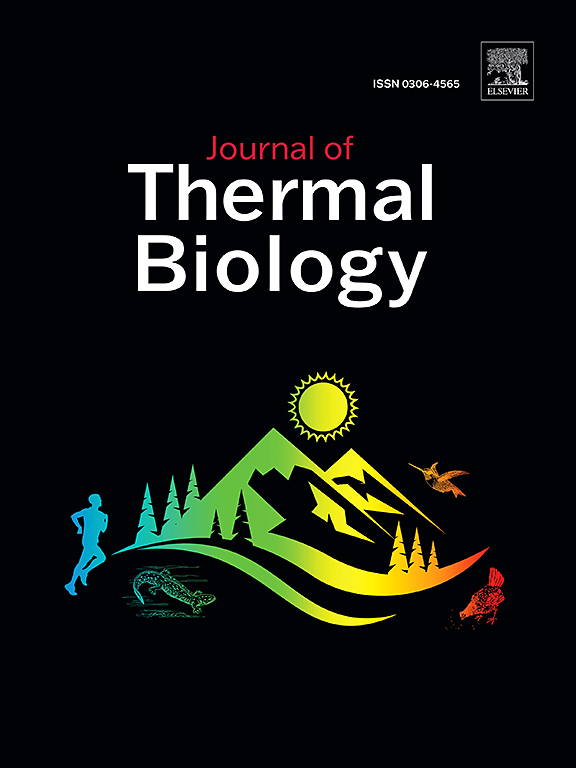The role of thermal biology in the co-occurrence of two endemic Liolaemus lizards from the temperate Pampas
IF 2.9
2区 生物学
Q2 BIOLOGY
引用次数: 0
Abstract
Partitioning of thermal resources promotes coexistence among closely related lizard species, even with apparent niche overlap. Different thermoregulatory strategies, microhabitat use, and thermal physiology are frequently observed in syntopic lizard species, facilitating the partition of resources. This study investigated the thermal biology of Liolaemus absconditus and Liolaemus tandiliensis, two syntopic lizard species inhabiting the Tandilia Mountain Range. We examined the influence of intrinsic traits and environmental variables on thermoregulatory strategy, thermal parameters, and locomotor performance. Despite experiencing suboptimal thermal conditions during summer, both species were moderate thermoregulators. Both species exhibited significant overlap in body condition, microhabitat use, and thermoregulatory traits (field body temperature and thermal preference). However, they presented subtle differences in thermoregulatory strategy, thermal tolerance, and thermal performance. Liolaemus absconditus relied heavily on thigmothermy and exhibited a higher tolerance for maximum critical temperature but a narrower optimal temperature range for locomotion than the opportunistic L. tandiliensis, which alternated between thigmothermy and heliothermy. These subtle interspecific physiological differences may reduce competition for thermal resources of these Liolaemus lizards. However, L. tandiliensis likely has an advantage over L. absconditus under suboptimal thermal conditions. The predominance of L. tandiliensis over L. absconditus in the study site highlights the need for further investigation into other ecological factors and physiological traits drive their coexistence.
温性潘帕斯两种特有种Liolaemus蜥蜴共生的热生物学作用
热资源的分配促进了密切相关的蜥蜴物种之间的共存,即使有明显的生态位重叠。同种蜥蜴在不同的温度调节策略、微生境利用和热生理方面经常被观察到,这有利于资源的分配。本文研究了生活在坦迪利亚山脉的两种合属蜥蜴——潜行蜥蜴和坦迪利亚蜥蜴的热生物学特性。我们研究了内在特征和环境变量对热调节策略、热参数和运动性能的影响。尽管在夏季经历了次优的热条件,但这两个物种都是适度的温度调节者。这两个物种在身体状况、微生境利用和温度调节特征(野外体温和热偏好)上有显著的重叠。然而,它们在热调节策略、热耐受性和热性能方面存在细微差异。相对于在母性和热性之间交替的机会性L. tandiliensis而言,Liolaemus abconditus对母性的依赖程度较高,对最高临界温度的耐受性较高,但对运动的最佳温度范围较窄。这些微妙的种间生理差异可能会减少这些Liolaemus蜥蜴对热资源的竞争。然而,在次优热条件下,L. tandiliensis可能比L. abconditus有优势。在研究地点,L. tandiliensis对L. abconditus的优势表明需要进一步研究其他驱动它们共存的生态因素和生理性状。
本文章由计算机程序翻译,如有差异,请以英文原文为准。
求助全文
约1分钟内获得全文
求助全文
来源期刊

Journal of thermal biology
生物-动物学
CiteScore
5.30
自引率
7.40%
发文量
196
审稿时长
14.5 weeks
期刊介绍:
The Journal of Thermal Biology publishes articles that advance our knowledge on the ways and mechanisms through which temperature affects man and animals. This includes studies of their responses to these effects and on the ecological consequences. Directly relevant to this theme are:
• The mechanisms of thermal limitation, heat and cold injury, and the resistance of organisms to extremes of temperature
• The mechanisms involved in acclimation, acclimatization and evolutionary adaptation to temperature
• Mechanisms underlying the patterns of hibernation, torpor, dormancy, aestivation and diapause
• Effects of temperature on reproduction and development, growth, ageing and life-span
• Studies on modelling heat transfer between organisms and their environment
• The contributions of temperature to effects of climate change on animal species and man
• Studies of conservation biology and physiology related to temperature
• Behavioural and physiological regulation of body temperature including its pathophysiology and fever
• Medical applications of hypo- and hyperthermia
Article types:
• Original articles
• Review articles
 求助内容:
求助内容: 应助结果提醒方式:
应助结果提醒方式:


